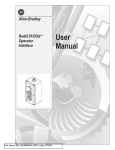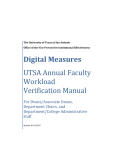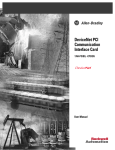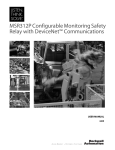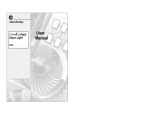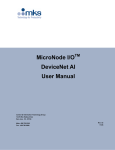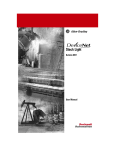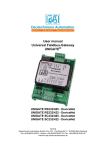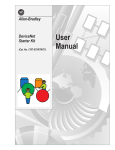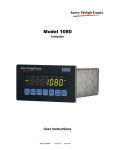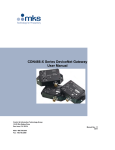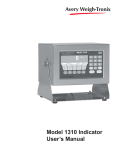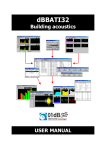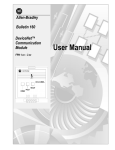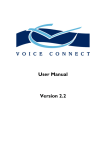Download 2705-UM001A-EN-P, RediSTATION Operator Interface User Manual
Transcript
RediSTATION™ Operator Interface User Manual Important User Information Because of the variety of uses for the products described in this publication, those responsible for the application and use of this control equipment must satisfy themselves that all necessary steps have been taken to assure that each application and use meets all performance and safety requirements, including any applicable laws, regulations, codes and standards. The illustrations, charts, sample programs and layout examples shown in this guide are intended solely for purposes of example. Since there are many variables and requirements associated with any particular installation, Allen-Bradley does not assume responsibility or liability (to include intellectual property liability) for actual use based upon the examples shown in this publication. Allen-Bradley publication SGI-1.1, Safety Guidelines for the Application, Installation and Maintenance of Solid-State Control (available from your local Allen-Bradley office), describes some important differences between solid-state equipment and electromechanical devices that should be taken into consideration when applying products such as those described in this publication. Reproduction of the contents of this copyrighted publication, in whole or part, without written permission of Rockwell Automation, is prohibited. Throughout this manual we use notes to make you aware of safety considerations: ATTENTION ! Identifies information about practices or circumstances that can lead to personal injury or death, property damage or economic loss Attention statements help you to: • identify a hazard • avoid a hazard • recognize the consequences IMPORTANT Identifies information that is critical for successful application and understanding of the product. Allen-Bradley is a trademark of Rockwell Automation. PLC and RediSTATION are registered trademarks of Rockwell Automation. Table of Contents Preface Objectives. . . . . . . . Intended Audience . Contents of Manual . Related Publications . . . . . . . . . . . . . . . . . . . . . . . . . . . . . . . . . . . . . . . . . . . . . . . . . . . . . . . . . . . . . . . . . . . . . . . . . . . . . . . . P-1 P-1 P-1 P-2 Overview of RediSTATION Chapter Objectives . . . . . . . . . . . Description . . . . . . . . . . . . . . . . . Standard Configuration . . . . . . . . Custom Configurations . . . . . . . . Unpopulated Configuration . . . . . Station Features. . . . . . . . . . . . . . LED Indicator . . . . . . . . . . . . . . . DIP Switches . . . . . . . . . . . . . . . I/O Connector . . . . . . . . . . . . . . Device Connection . . . . . . . . . . . DeviceNet Sealed Connector . DeviceNet Terminal Block . . . Typical DeviceNet Configuration . DeviceNet Components. . . . . . . . Replacement Parts. . . . . . . . . . . . Catalog Number Configuration. . . . . . . . . . . . . . . . . . . . . . . . . . . . . . . . . . . . . . . . . . . . . . . . . . . . . . . . . . . . . . . . . . . . . . . . . . . . . . . . . . . . . . . . . . . . . . . . . . . . . . . . . . . . . . . . . . . . . . . . . . . . . . . . . . . . . . . . . . . . . . . . . . . . . . . . . . . . . . . . . . . . . . . . . . . . . . . . . . . . . . . . . . . . . . . . . . . . . . . . . . . . . . . . . . . . . . . . . . . . . . . . . . . . . . . . . . . . . . . . . . . . . . . . . . . . . . . . . . . . . . . . . . . . . . . . . . . . . . . . . . . . . . . . . . . . . . . . . . . . . . . . . . . 1-1 1-2 1-3 1-3 1-4 1-4 1-5 1-5 1-6 1-7 1-7 1-7 1-8 1-9 1-9 1-10 Installation and Mounting Chapter Objectives . . . . . . . . . . . . . . . . DeviceNet Guidelines . . . . . . . . . . . . . . Equipment Needed . . . . . . . . . . . . . . . . Removing the Enclosure Cover . . . . . . . Setting the DIP Switches . . . . . . . . . . . . Setting the DeviceNet Node Address. Setting the Data Rate . . . . . . . . . . . . Setting the Output Fault State . . . . . . Setting the Output Flash Rate . . . . . . DeviceNet Termination . . . . . . . . . . . . . RediSTATION Dimensions. . . . . . . . . . . Mounting the RediSTATION . . . . . . . . . Securing Enclosure Cover . . . . . . . . . . . Connecting to the DeviceNet Network . . . . . . . . . . . . . . . . . . . . . . . . . . . . . . . . . . . . . . . . . . . . . . . . . . . . . . . . . . . . . . . . . . . . . . . . . . . . . . . . . . . . . . . . . . . . . . . . . . . . . . . . . . . . . . . . . . . . . . . . . . . . . . . . . . . . . . . . . . . . . . . . . . . . . . . . . . . . . . . . . . . . . . . . . . . . . . . . . . . . . . . . . . . . . . . . . . . . . . 2-1 2-1 2-1 2-2 2-2 2-3 2-4 2-4 2-5 2-5 2-6 2-7 2-8 2-9 i . . . . . . . . . . . . . . . . . . . . . . . . . . . . . . . . . . . . Publication 2705-UM001A-EN-P Table of Contents ii Operations Chapter Objectives . . . . . Modes of Operation . . . . Powerup/Reset Mode. Idle Mode . . . . . . . . . Run Mode . . . . . . . . . Error Mode . . . . . . . . Resetting the Device . . . . DeviceNet Operations . . . . . . . . . . . . . . . . . . . . . . . . . . . . . . . . . . . . . . . . . . . . . . . . . . . . . . . . . . . . . . . . . . . . . . . . . . . . . . . . . . . . . . . . . . . . . . . . . . . . . . . . . . . . . . . . . . . . . . . . . . . . . . . . . . . . . . . . . . . . . . . . . . . . . . . . . . . . . . . . . . . . . . . . . . . . . . . . . . . . . . . . . . . . . . . . . . . . . . . . . . . 3-1 3-1 3-1 3-2 3-2 3-3 3-3 3-4 Troubleshooting and Maintenance Chapter Objectives . . . . . . . . . . . . . . . . . . . . . . . . . . . . . . . . 1 Preventive Maintenance. . . . . . . Using the LED Indicator . . . . . . Replacing RediSTATION devices Replacing a Pilot Lamp Light . . . . . . . . . . . . . . . . . . . . . . . . . . . . . . . . . . . . . . . . . . . . . . . . . . . . . . . . . . . . . . . . . . . . . . . . . . . . . . . . . . . Building a Custom RediSTATION Chapter Objectives . . . . . . . . . Custom Build Components . . . Operators and Indicators . . . . . Assembling the RediSTATION . . . . . . . . . . . . . . . . . . . . . . . . . . . . . . . . . . . . . . . . . . . . . . . . . . . . . . . . . . . . . . . . . . . . . . . . . . . . . . . . . . . . . 5-1 5-1 5-2 5-3 Specifications Electrical. . . . . . . Mechanical . . . . . Environment . . . . Communications . Certifications. . . . . . . . . . . . . . . . . . . . . . . . . . . . . . . . . . . . . . . . . . . . . . . . . . . . . . . . . . . . . . . . . . . . . . . . . . . . . . . . . . . . . . . . . . . . . . . . . . . . . . . . . . . . . . . . . . A-1 A-1 A-2 A-2 A-2 DeviceNet Information DeviceNet Message Types . . . . DeviceNet Class Services . . . . . DeviceNet Object Classes . . . . Identity Object . . . . . . . . . . . . DeviceNet Object . . . . . . . . . . Connection Object . . . . . . . . . Assembly Objects . . . . . . . . . . Discrete Input Objects. . . . . . . Discrete Output Point Objects . . . . . . . . . . . . . . . . . . . . . . . . . . . . . . . . . . . . . . . . . . . . . . . . . . . . . . . . . . . . . . . . . . . . . . . . . . . . . . . . . . . . . . . . . . . . . . . . . . . . . . . . . . . . . . . . . . . . . . . . . . . . . . . . . . . . . . . . . . . . . . . . . . . . . . . . . . . . . . . . . . . . . . . . . . . . . . . . . . . . . . . . . . . . . . B-1 B-1 B-2 B-2 B-4 B-5 B-7 B-8 B-9 User Configuration Kit Contents . . . . . . . . . . . . . . . . . . . . . . . . Specifications of DeviceNet Interface Board . Mounting Dimensions . . . . . . . . . . . . . . . . . Connecting Devices . . . . . . . . . . . . . . . . . . . . . . . . . . . . . . . . . . . . . . . . . . . . . . . . . . . . . . . . . . . . . . C-1 C-2 C-3 C-4 Index Publication 2705-UM001A-EN-P . . . . . . . . . . . . . . . . . . . . . . . . . . . . . . . . . . . . . . . . . . . . . . . . . . . . . 1 2 3 5 Preface Objectives This manual gives an overview of the Bulletin 2705 RediSTATION operator interface and describes how to configure, install, operate and troubleshoot the device on the DeviceNet network. Intended Audience This manual is for the individuals responsible for installing, mounting and operating the RediSTATION in an industrial environment. You should understand DeviceNet network operations, including how slave devices operate on the network and communicate with a DeviceNet master. Contents of Manual Chapter 1 Title Description Preface Describes the purpose and contents of the manual, and intended audience. 1 Overview Gives an overview of the features of the RediSTATION Operator Interface. 2 Installation and Mounting Shows how to configure, mount and install the RediSTATION on a DeviceNet network. 3 Operations Describes RediSTATION operations and other pertinent operation. 4 Troubleshooting and Maintenance Gives information on how to troubleshoot and maintain the RediSTATION. 5 Building Custom Units Tells how to assemble separate components of a RediSTATION device. A Specifications Gives electrical, mechanical and environmental specifications. B DeviceNet Information Describes DeviceNet message types, class services, and object classes supported by the RediSTATION. C Unpopulated Configuration Describes components and instructions for installing the unpopulated version of the RediSTATION. Publication 2705-UM001A-EN-P Preface 2 Related Publications Publication 2705-UM001A-EN-P The following table lists DeviceNet related publications you might want to refer to. Publication Title Publication Number DeviceNet Cable System Planning and Installation Manual DN-6.7.2 1771-SDN Scanner Module Installation Instructions 1771-5.14 1747-SDN Scanner Module Installation Instructions 1747-5.8 Chapter 1 Overview of RediSTATION Chapter Objectives 1 This chapter provides an overview of the RediSTATION and its features. It contains the following sections: Section Page Description 1-2 Standard Configuration 1-2 Custom Configurations 1-3 Unpopulated Configurations 1-4 Station Features 1-4 LED Indicator 1-5 DIP Switches 1-5 I/O Connector 1-6 DeviceNet Connection 1-7 Typical DeviceNet Configuration 1-8 DeviceNet Components 1-9 Replacement Parts 1-9 Catalog Number Configurations 1-10 Publication 2705-UM001A-EN-P 1-2 Overview of RediSTATION Description The Bulletin 2705 RediStation is a 3-button station that operates on the DeviceNet network. The station receives power from the DeviceNet network. A separate power supply is not required. The station supports three 800T devices in a standard or custom configuration. The standard unit includes two push buttons and one pilot light that are prewired for easy installation. Custom configurations support a variety of 800T devices that are prewired or customer installed. The die cast enclosure of the standard unit complies with NEMA Type 4/12/13 standards for operation in rugged industrial environments. DeviceNet Connector Die Cast Enclosure Three 800T Devices Summary of Features • Standard or custom configurations • Surface mounting device • NEMA Type 4/12/13 die cast enclosure • Easy installation and startup • DeviceNet compatibility • Powered by DeviceNet connection (no power supply required) • Mod/Net Status LED provides indication of network and device operation Publication 2705-UM001A-EN-P Overview of RediSTATION Standard Configuration 1-3 The standard RediSTATION unit (Catalog No. 2705-T3DN1A42A) has 2 push buttons (start and stop) and 1 pilot light. • Catalog No. 800T-A1A Flush Head Push Button • Catalog No. 800T-B6A Extended Head Push Button • Catalog No. 800T-Q24R Pilot Light The devices are prewired. 800T-Q24R Pilot Light (red cap, 24V incandescent lamp) 800T-A1A Flush Head Push Button (green, 1 NO Contact, 1 NC Contact) 800T-B6A Extended Head Push Button (red, 1 NO Contact, 1 NC Contact) Custom Configurations You can order custom configurations to include other 800T devices that are prewired or customer installed. The RediSTATION supports direct connection to shallow contact blocks and 24 VDC incandescent lamps: • push buttons, illuminated/non-illuminated • selector switches, illuminated/non-illuminated • key switches • pilot lights Other 800T devices are supported if the depth of the device is less than 1.92 inches (48.8 mm). Measure the device from the front mounting surface to the back of the 800T device. Device depth must not exceed 1.92 inches (48.8 mm) Publication 2705-UM001A-EN-P 1-4 Overview of RediSTATION Unpopulated Configuration An unpopulated configuration is available for customer configuration and installation of operator devices. The unpopulated configuration includes: • DeviceNet Interface Board • Six I/O Connector Cables (supporting 4 inputs and 2 outputs) • DeviceNet PCB Terminal Block • Mounting Hardware Refer to Appendix C. Station Features RediSTATION features are visible when the cover of the enclosure is removed. I/O Connector I/O Cables DeviceNet Interface Board LED Cover DIP Switch DeviceNet Connector Publication 2705-UM001A-EN-P Overview of RediSTATION LED Indicator 1-5 The RediSTATION has one bicolor LED (red/green) to show its operating status. The LED shows the following indications. Color State Indication None Off No power Red Solid Unrecoverable fault Flashing Output error or configuration error Solid Normal runtime operation Green The RediSTATION device is operating as a slave to the master controller. Flashing Device is idle or not allocated to a master. The LED is visible when the cover of the enclosure is removed. DIP Switches The RediSTATION has one 10-position DIP switch for setting: • DeviceNet Node Address • DeviceNet Data Rate • Output Fault State (Off or Last State) • Output Flash Rate The DIP switch is located on the circuit board inside the enclosure. The switch settings and functions are shown below. The default setting for each switch or group of switches is underlined. Default Configuration OFF = 0 ON = 1 10 9 8 7 6 5 4 3 2 1 DeviceNet Address 000000 - 111111 (0 to 63) DeviceNet Data Rate 00 = 125K BPS 01 = 250K BPS 10 = 500K BPS 11 = Invalid Output Fault State 0 = Outputs Turn Off on Fault 1 = Outputs Hold Last State on Fault Output Flash Rate 0 = 1 Hz (0.5 sec On, 0.5 sec Off) 1 = 2 Hz (0.25 sec On, 0.25 sec Off) Publication 2705-UM001A-EN-P 1-6 Overview of RediSTATION I/O Connector Bulletin 800T devices connect to the 12-pin I/O connector on the circuit board. The connector supports 4 inputs and 2 outputs. The standard configuration uses 2 inputs and 1 output. A separate cable attaches each 800T input or output device to the I/O connector. The 2-wire end of the cable attaches to the screw terminals of the device. The connector end of the cable connects to 2-pins on the I/O connector. Unused pins are left open. The table below shows connections for the standard configuration. The pilot light connects to pins 1-2. The start push button connects to pins 9-10. The stop push button connects to pins 11-12. Pins 3-8 are unused. I/O Connector Pin# Wire Color 800T Terminal Labels 1 Red L1(+) 2 Black L2(-) 9 Red A3 10 Black A4 11 Red A3 12 Black A4 800T Device Indicator Start Push Button Stop Push Button The illustration on the left shows the location of the I/O connector on the circuit board. The illustration on the right shows the terminal labels for each device in the standard configuration. B 1 3 B 2 4 3 A1 I/O Connector Pin 1 Publication 2705-UM001A-EN-P Stop Push Button 1 3 2 4 A Start Push Button L1(+) L2(-) Indicator Overview of RediSTATION Device Connection 1-7 The RediSTATION receives all power and communications through the DeviceNet cable. A separate power supply is not required. This is the only external connection to the RediSTATION. The RediSTATION connects to the DeviceNet network using either the sealed connector on the top of the unit or the DeviceNet terminal block inside the enclosure. DeviceNet Sealed Connector On standard units, the DeviceNet cable attaches directly to the DeviceNet connector at the top of the enclosure. The connector is wired to the DeviceNet terminal block on the circuit board. DeviceNet Connector DeviceNet Connector 3 4 5 2 1 Pin # Signal Function Color 1 SHIELD Shield Green 2 VDC+ Power Supply Red 3 COM Common Black 4 CAN_H Signal High White 5 CAN_L Signal Low Blue DeviceNet Terminal Block On stations without a sealed connector, DeviceNet cable wires (2 communication, 2 power, 1 shield) connect to the terminal block through the conduit at the top of the unit. DeviceNet Terminal Block Conduit for DeviceNet Cable 1 6 Pin # Signal Function Color 1 COM Common Black 2 CAN_L Signal Low Blue 3 SHIELD Shield Uninsulated 4 CAN_H Signal High White 5 VDC+ Power Supply Red 6 E. GND Chassis Ground Green Publication 2705-UM001A-EN-P 1-8 Overview of RediSTATION Typical DeviceNet Configuration A DeviceNet network supports multiple RediSTATION devices and allows them to communicate with other network devices (up to 64). The RediSTATION operates on the network as a slave device. It does not initiate communications except for a duplicate node address check on powerup. The master reads inputs from RediSTATION input devices and writes data to the output devices. The following DeviceNet configuration shows a variety of sensors operating as slaves to a PLC-5 controller with a 1771-SDN DeviceNet Scanner Module. PLC-5 Controller DeviceNet Scanner Module DeviceNet Network Sensor Block I/O Smart Motor Controller RediSTATION Publication 2705-UM001A-EN-P Drive RediSTATION Overview of RediSTATION DeviceNet Components 1-9 DeviceNet cables and components are available from Allen–Bradley as separate catalog numbers. It is your responsibility to install and implement the DeviceNet network and supported devices according to the DeviceNet guidelines. Replacement Parts The Standard RediSTATION unit is completely assembled and does not have accessories. Replacement parts for 800T components (operators, pilot lights, legend plates) are available as separate catalog numbers. Publication 2705-UM001A-EN-P 1-10 Overview of RediSTATION Catalog Number Configuration The following catalog number configuration shows how to order standard or custom built RediSTATION units. 2705 - T3DN1A42A - XXXXX Bulletin Number Button Type: T = 800T Number of Operators: 3 Custom Layout See Publication 2705-3.3 Configuration Type: A = Standard 1 Pilot Light 1 Start Button 1 Stop Button X = Custom Z = Unpopulated Network Type: DN = DeviceNet Enclosure Type: 1 = Die Cast DeviceNet Connector: A = Sealed B = Terminal Block Publication 2705-UM001A-EN-P Board Type: 42 = 4 Inputs, 2 Outputs Chapter 2 Installation and Mounting Chapter Objectives This chapter describes how to install and mount a standard or custom RediSTATION. It contains the following sections: Section Page DeviceNet Guidelines 2-1 Equipment Needed 2-1 Removing the Enclosure Cover 2-2 Setting the DIP Switches 2-2 DeviceNet Termination 2-5 RediSTATION Dimensions 2-6 Mounting the RediSTATION 2-7 Securing the Enclosure Cover 2-8 Connecting to a DeviceNet Network 2-9 DeviceNet Guidelines It is your responsibility to install and implement the DeviceNet network and supported devices according to the DeviceNet guidelines. Equipment Needed Install the RediSTATION using standard electricians tools. • Wire strippers • Slotted screwdriver 1 Publication 2705-UM001A-EN-P 2-2 Installation and Mounting Removing the Enclosure Cover To set the configuration parameters of the RediSTATION and mount the enclosure, you must remove the enclosure cover. To remove the enclosure cover: 1. Using a slotted screwdriver, remove the 6 cover screws. 2. Carefully remove the cover so as not to disconnect any wires. 3. Remove the DeviceNet terminal block connector from the circuit board. Do not disconnect any wiring. Removable Terminal Block Connector Cover Assembly 4. Store the enclosure cover in a safe location; it is not required for mounting the enclosure. Setting the DIP Switches The setting of the DIP switch on the circuit board determines: • • • • DeviceNet node address DeviceNet data rate Output fault state Output flash rate The location of the DIP switch and the factory defaults are shown below. DIP Switches OFF = 0 ON = 1 10 9 Publication 2705-UM001A-EN-P 8 7 6 5 4 3 2 1 Installation and Mounting 2-3 Setting the DeviceNet Node Address DIP switches 1 to 6 set the node address (0 to 63) of the RediSTATION on the DeviceNet network. The address is set using binary addressing. OFF = 0 ON = 1 10 9 8 7 6 5 4 3 2 1 DeviceNet Address 000000 - 111111 (0 to 63) The table below shows the switch settings for each address (0 to 63). To set the DeviceNet node address: 1. Refer to the table below for switch settings of a specific address. 2. Using your finger or a pointed object, slide switches 1 to 6 to the appropriate ON/OFF positions. ATTENTION Do not use a pencil. Graphite from the pencil is conductive and may damage DIP Switch. ! DeviceNet Address Switch Settings 6← 1 DeviceNet Address Switch Settings 6← 1 DeviceNet Address Switch Settings 6← 1 DeviceNet Address Switch Settings 6← 1 0 000000 16 010000 32 100000 48 110000 1 000001 17 010001 33 100001 49 110001 2 000010 18 010010 34 100010 50 110010 3 000011 19 010011 35 100011 51 110011 4 000100 20 010100 36 100100 52 110100 5 000101 21 010101 37 100101 53 110101 6 000110 22 010110 38 100110 54 110110 7 000111 23 010111 39 100111 55 110111 8 001000 24 011000 40 101000 56 111000 9 001001 25 011001 41 101001 57 111001 10 001010 26 011010 42 101010 58 111010 11 001011 27 011011 43 101011 59 111011 12 001100 28 011100 44 101100 60 111100 13 001101 29 011101 45 101101 61 111101 14 001110 30 011110 46 101110 62 111110 15 001111 31 011111 47 101111 63 111111 Publication 2705-UM001A-EN-P 2-4 Installation and Mounting Setting the Data Rate DIP switches 7 and 8 set the data rate at which the RediSTATION communicates on the DeviceNet network. The factory default is 125K. OFF = 0 ON = 1 10 9 8 7 6 5 4 3 2 1 DeviceNet Data Rate 00 = 125K BPS 01 = 250K BPS 10 = 500K BPS 11 = Unused The data rate determines the maximum length of the DeviceNet cable. Data Rate Cable Length (Maximum) 125K BPS 500 meters (1600 feet) 250K BPS 200 meters (600 feet) 500K BPS 100 meters (300 feet) To set the DeviceNet data rate: 1. Refer to the table above to select the correct data rate. 2. Slide switches 7 and 8 to the appropriate ON/OFF positions. Setting the Output Fault State DIP switch 9 sets the state of the outputs (pilot lights) when the device detects an error. The factory default setting is to turn the outputs off when an error is detected. The station ignores push button presses in the error state. When communication is regained, the station updates itself and resumes operation. OFF = 0 ON = 1 10 9 8 7 6 5 4 3 2 1 Output Fault State 0 = Outputs Turn Off on Fault 1 = Outputs Hold Last State on Fault Output Fault States Description Outputs Turn Off on Error When communication is lost, the station turns off outputs. Outputs Retain Last State When communication is lost, the outputs remain in their last state. To change the fault state, slide switch 9 to the correct ON/OFF setting. Publication 2705-UM001A-EN-P Installation and Mounting 2-5 Setting the Output Flash Rate DIP switch 10 sets the flash rate of the outputs (pilot lights). The factory default setting is 1 Hz. OFF = 0 ON = 1 10 9 8 7 6 5 4 3 2 1 Output Flash Rate 0 = 1 Hz (0.5 sec, On, 0.5 sec Off) 1 = 2 Hz (0.25 sec On, 0.25 sec Off) To change the flash rate, slide switch 10 to the appropriate ON/OFF position. DeviceNet Termination Devices on end nodes of the DeviceNet network require termination. If the RediSTATION is an end node, you must provide network termination. To terminate the RediSTATION, install a 121 ohm 1% metal film resistor between the CAN_High and CAN_Low terminals on the DeviceNet terminal block. DeviceNet Removable Terminal Block CAN_Low CAN_High Publication 2705-UM001A-EN-P 2-6 Installation and Mounting RediSTATION Dimensions The figure below shows the dimensions of the standard RediSTATION. For custom built stations, the depth may vary depending upon the 800T operators or pilot lights installed. 4.41 inch (112.0 mm) 3.22 inch 81.8 mm) 3.81 inch (96.8 mm) 8.26 inch (209.8 mm) 7.56 inch (192.0 mm) Publication 2705-UM001A-EN-P Installation and Mounting Mounting the RediSTATION 2-7 The RediSTATION mounts on a flat surface. The back of the unit has 4 holes that accept a 10-32 (5mm) screw. To maintain a watertight seal, use sealing grommets with screws. The screw length must be 1/2 inch (12.7 mm) plus the depth of the material into which the screw is mounted. The head of the screws must be 3/8 inch or less to fit in the sealed mounting holes. For proper grounding, mount the enclosure to a grounded metal plate. Scrape the paint around the screw holes of the enclosure and plate to ensure good metal-to-metal contact. Allow a clearance of at least 3 inches (76.2 mm) at the top of the enclosure for connecting the DeviceNet cable. Allow 3-inch clearance for DeviceNet cable 4 Holes .203 inch (5.2 mm) diameter 6.25 inch (158.7 mm) RediSTATION Back Side 3.00 inch (76.2 mm) Sealed Mounting Hole Sealing Grommets 10-32 (5mm) screws Heads of screws must be smaller than 3/8 inch to fit inside mounting Publication 2705-UM001A-EN-P 2-8 Installation and Mounting Securing Enclosure Cover After setting the DIP switches and mounting the enclosure, secure the cover of the enclosure. To secure the enclosure cover: 1. Plug the DeviceNet terminal block connector into the circuit board. Plug Connector into Circuit Board Removable Terminal Block Connector 2. Secure the cover of the enclosure with the six cover screws. Tighten screws to 20 in-lbs to ensure proper seal. Tighten 6 Screws to 20 in-lbs Publication 2705-UM001A-EN-P Installation and Mounting Connecting to the DeviceNet Network 2-9 On standard units with the sealed connector, it is not necessary to disconnect incoming power from DeviceNet network before connecting the RediStation. The DeviceNet cable connects directly to the connector on the top of the enclosure or through the conduit opening. DeviceNet Cable DeviceNet cable wires connect to terminal block through the conduit opening. Hole requires sealed fitting to maintain NEMA Type 4 environmental rating. Important: When connecting conduit to the enclosure, use UL listed or recognized conduit hubs with the same environmental rating as the enclosure. Publication 2705-UM001A-EN-P 2-10 Installation and Mounting Publication 2705-UM001A-EN-P Chapter 3 Operations Chapter Objectives Modes of Operation This chapter contains the following sections: Section Page Modes of Operations 3-1 Resetting the Device 3-3 DeviceNet Operations 3-4 The RediSTATION has 4 modes of operations: Powerup / Reset Mode, Idle Mode, Run Mode, and Error Mode. Powerup/Reset Mode During a powerup or reset, the RediSTATION: 1. Clears outputs (turns outputs off) and cycles the LED indicator through solid red, green and off. The LED remains off until the test is completed. 2. Performs powerup diagnostic tests including: - EPROM checksum test RAM read/write test Watchdog timer test Serial number verification If any test fails, the outputs remain off and the LED shows solid red. You must cycle power to recover from a powerup diagnostic test failure. Repeated failures indicate a faulty unit. 3. Reads and stores the DIP switch settings. Important: Changes to DIP switch settings are allowed only in powerup or reset mode. Changes to DIP switch settings under power cause an error. 1 Publication 2705-UM001A-EN-P 3-2 Operations 4. Performs a duplicate node address check to verify that another node is not assigned the same DeviceNet address as the RediSTATION device. If a duplicate node error occurs, the outputs turn off and the status LED is set to red. You must cycle power to clear the error. Idle Mode If the powerup or reset is successful, the RediSTATION enters idle mode and the LED flashes green. When the RediSTATION establishes a connection with a master device, it enters run mode (LED is solid green). Run Mode After a successful powerup or reset, the RediSTATION enters run mode and operates as a slave to a master device. In run mode, the: • controller scans switch inputs and writes lamp outputs. • station accepts output messages and poll messages from other nodes on the DeviceNet network. • station monitors outputs for underloads/overloads. If an output error is detected, the RediSTATION sets the appropriate message bits and remains in run mode. In run mode, you can set the outputs to on, off or flashing. DIP switch 10 controls the rate of flashing for outputs. The RediSTATION also supports DeviceNet explicit messages that are received over the network. Explicit messages are used to configure and verify RediSTATION settings. If all connections with the master device are closed or deleted (timed out), the RediSTATION returns to idle mode. An explicit connection with an Expected Packet Rate (EPR) value of 0 never times out. Publication 2705-UM001A-EN-P Operations 3-3 Error Mode In error mode (LED turns red), the RediSTATION monitors the error state for correct operation. Errors are critical or noncritical. Error Type Description LED State Critical (Not recoverable) Failure of diagnostic tests during powerup/reset mode Solid Red Over-temperature condition of outputs during runtime Changes to DIP switches during runtime Duplicate node address detected Incorrect data rate Non-critical (Recoverable) Pilot lamp burned out Flashing Red Pilot lamp wired incorrectly I/O connection timeout See the troubleshooting chart on page 4-2 for details on how to recover from an error. Resetting the Device To reset the RediSTATION, you must cycle power to the unit or briefly disconnect the DeviceNet connector. Publication 2705-UM001A-EN-P 3-4 Operations DeviceNet Operations The Allen-Bradley 1747-SDN and 1771-SDN DeviceNet Scanner Modules are master devices on the DeviceNet network. The RediSTATION supports the Master/Slave Connection Set for master/ slave communications on the DeviceNet network. To communicate with a RediSTATION, the DeviceNet Scanner Module must be configured with the RediSTATION: • node address • input bytes (1) • output bytes (1) The DeviceNet Scanner Module: • connects to the RediSTATION slave device • performs the appropriate connection configuration • polls the RediSTATION for inputs and outputs Response Times The RediSTATION responds to a DeviceNet Scanner poll within 1 millisecond. The switch inputs are debounced for 50 milliseconds. When a change of state is detected, the inputs are not read for another 50 milliseconds Publication 2705-UM001A-EN-P Chapter 4 Troubleshooting and Maintenance Chapter Objectives Preventive Maintenance This chapter contains the following sections: Section Page Preventive Maintenance 4-1 Using the LED Indicator 4-2 Replacing RediSTATION devices 4-3 Replacing a Pilot Lamp 4-5 • Prevent accumulation of dust and dirt by keeping – enclosure clean – enclosure covered • Periodically check for loose connections. ATTENTION To avoid shock hazard, remove incoming power before checking connections. ! 1 Publication 2705-UM001A-EN-P 4-2 Troubleshooting and Maintenance Using the LED Indicator The LED provides status information on RediSTATION operations. The LED is visible when the enclosure cover is removed. The troubleshooting chart shows LED indications. It also shows how to use the LED to detect and correct common operating problems. LED Color State None Red Red Solid Flashing Meaning What to do RediSTATION not receiving input power. Check DeviceNet power/cable connections and check the power connection on the DeviceNet terminal block. See page 1-7. Diagnostics failed on powerup/reset. Internal fault. Reset device. If fault persists, return RediSTATION for repair. DIP switch settings changed after powerup. DIP switch settings are read only during a powerup or a reset. Power off the RediSTATION. Set DIP switch settings. Turn power on. Over-temperature error detected during runtime. Outputs turn off. Check ambient temperature rating. Reset device. Invalid data rate Reset DIP switches 7 and 8 to a valid DeviceNet data rate. See page 2-4 for valid data rates and cable lengths. Reset device. Duplicate DeviceNet node address. Two nodes cannot have the same address. Reset DIP switches 1 through 6 using a valid address. See page 2-3 for a table of possible address settings. Reset device. Plot light lamp is burnt out. Replace pilot lamp bulb. Pilot light is not wired correctly to the I/O connector or the screw terminals of the device. Check I/O cable connections for the pilot light. I/O connection timeout Reset Device. Green Solid Normal operating state and device is allocated to a master device. No action required. Green Flashing Device is online but not allocated to a master. Check DeviceNet master for correct RediSTATION configuration information (node address, input bytes, output bytes). Device is in idle state. Check DeviceNet master for proper operation. The LED does not indicate the following malfunctions. Problem Meaning What to do Switch or button operators do not function Loose wiring Check wiring and cable connections. Incorrect address Check address setting of the DIP switch. Faulty contacts, switch or button Use an ohmmeter to verify opening/closing of contacts. Publication 2705-UM001A-EN-P Troubleshooting and Maintenance Replacing RediSTATION devices ATTENTION 4-3 To avoid electrical shock or unintended operation of the equipment, remove power before servicing. ! To replace a RediSTATION device: 1. Remove the (6) enclosure cover screws. 2. Disconnect DeviceNet terminal block connector from the circuit board. 3. Remove circuit board from back of the 800T devices. Remove the 2 circuit board screws and spacers. Spacers Circuit Board Circuit Board Mounting Screws 4. Disconnect wiring for the device you want to replace. 5. Remove device from enclosure cover. 6. Mount the replacement 800T device to the enclosure cover. Refer to the instruction sheet that accompanies each device for mounting instructions. All devices should have connection terminals on the same side. Publication 2705-UM001A-EN-P 4-4 Troubleshooting and Maintenance Lamp Reflector (Lamps only) Locknut Gasket Thrust Washer Bonding Spring Trim Washer or Legend Plate Gasket Cover with Gasket Orient device connection terminals as shown above. 7. Mount the circuit board to the back of the 800T devices with the DeviceNet terminal block oriented toward sealed connector/ conduit hole of enclosure. Use the 2 screws and plastic spacers. Tighten circuit board mounting screws to 14 in-lbs. 8. Connect the 800T device terminals to the I/O connector using an I/O cable. An I/O cable consists of a twisted wire pair. Each set of contacts or pilot light connects to an I/O cable. See page 1-6 for a description of the I/O connector. I/O Connector I/O Cable ATTENTION ! Do not connect I/O pins to external devices or control circuits. Connecting pins to these devices will damage the circuit board. 9. Plug the DeviceNet terminal block connector into the circuit board. 10. Secure cover with the 6 mounting screws. Tighten screws to 20-in lbs. Publication 2705-UM001A-EN-P Troubleshooting and Maintenance Replacing a Pilot Lamp Light 4-5 Pilot light lamps can be replaced easily without opening enclosure. To replace a pilot light lamp: ATTENTION To avoid electrical shock or unintended operation of the equipment, remove power. ! 1. Remove lens cap from the pilot light. 2. Remove lamp from socket. ATTENTION Do not use a screwdriver or other metal object to remove lamp. ! 3. Carefully insert new lamp in socket. ATTENTION Before replacing the lens cap, be sure the lamp is seated properly or a short may result. ! 4. Replace the lens cap. 5. Check for proper operation. Publication 2705-UM001A-EN-P 4-6 Troubleshooting and Maintenance Publication 2705-UM001A-EN-P Chapter 5 Building a Custom RediSTATION Chapter Objectives This chapter describes how to create a RediSTATION. Custom Build Components Section Page Custom Build Components 5-1 Operators and Indicators 5-2 Assembling the RediSTATION 5-3 RediSTATION components can be ordered separately and customer installed. 800T operators and indicators must be purchased separately. 6 Cover Mounting Screws 2 Circuit Board Mounting Screws Circuit Board Cover with Gasket DeviceNet Terminal Block Circuit Board Spacers (sizes depend on device) Enclosure I/O Cables Prewired DeviceNet Connector or Conduit Hole 1 Publication 2705-UM001A-EN-P 5-2 Building a Custom RediSTATION Operators and Indicators The RediSTATION supports all Allen-Bradley 800T operators and pilot lights including: • maintained push buttons, illuminated, non–illuminated • momentary push buttons, illuminated, non–illuminated • interlocked push buttons, illuminated, non–illuminated • push pull buttons, illuminated, non–illuminated • selector switches, illuminated, non–illuminated • pilot lights • 2-3-4 way toggle switches All pilot lights must be rated for 24 VDC. ATTENTION ! Publication 2705-UM001A-EN-P Use only Allen-Bradley 800T devices in the RediSTATION. 800T devices maintain the NEMA rating of the enclosure and allow for proper installation of the circuit board. Building a Custom RediSTATION Assembling the RediSTATION 5-3 To assemble a RediSTATION device: 1. Mount the 800T devices to the enclosure cover. Refer to the instruction sheet that accompanies each device for mounting instructions. All of the devices should have the connection terminals on the same side. Lamp Reflector (Lamps only) Locknut Gasket Thrust Washer Bonding Spring Trim Washer or Legend Plate Gasket Cover with Gasket Orient device connection terminals as shown. 2. Connect the 800T device terminals to the I/O connector using the I/O cables. An I/O cable consists of a twisted (red/black) wire pair. Each set of contacts or pilot light connects to an I/O cable. I/O Connector I/O Cable ATTENTION ! Do not connect I/O pins to external devices or control circuits. Connecting pins to these devices will damage the circuit board. Publication 2705-UM001A-EN-P 5-4 Building a Custom RediSTATION Every 2 consecutive pins on the I/O connector connects to an I/O cable connector. The I/O connector supports 2 outputs/4 inputs. I/O Connector I/O Cable (up to 6) To Output (Pilot Light) To Output (Pilot Light) To Input (Contact) To Input (Contact) To Input (Contact) To Input (Contact) Circuit Board To simplify wiring, input devices and output devices attach to opposite ends of the I/O connector. The following table defines pin functions on the I/O connector. Output devices connect to pin 1-2 and 3-4. Input devices connect to pins 5-6, 7-8, 9-10 and 11-12. Unused pins are left open. I/O Connector Pin # Publication 2705-UM001A-EN-P Pin Label Function 1 OUT1+ Connects Output Device 2 OUT1- 3 OUT2+ 4 OUT2- 5 IN4+ 6 IN4- 7 IN3+ 8 IN3- 9 IN2+ 10 IN2- 11 IN1+ 12 IN1- Connects Output Device Connects Input Device Connects Input Device Connects Input Device Connects Input Device Building a Custom RediSTATION 5-5 3. Mount the circuit board to the back of the 800T devices with the DeviceNet terminal block oriented toward sealed connector/ conduit hole of enclosure. Use the two screws and plastic spacers provided (2 sizes provided for different 800T device depths). Tighten circuit board mounting screws to 14 in-lbs. Spacers Toward sealed connector/ conduit hole of enclosure Circuit Board Circuit Board Mounting Screws 4. If you are not using a prewired DeviceNet connector, pull the DeviceNet cable through the conduit at the top of the enclosure. Then attach the 6 DeviceNet cable leads to the removable terminal block connector. Page 1-7 provides a description of the DeviceNet connections. ATTENTION ! Do not connect the DeviceNet network to the DeviceNet terminal block connector when power is applied to the network or you may damage the circuit board or the DeviceNet network. Pin 1 Common CAN Low Shield CAN High VDC+ E GND ATTENTION ! Removable Terminal Block Connector Pin 6 Use conduit fittings with proper seals on the DeviceNet cable to maintain a watertight enclosure. Publication 2705-UM001A-EN-P 5-6 Building a Custom RediSTATION 5. Plug the DeviceNet terminal block connector into the circuit board. Plug Connector into Circuit Board Removable Terminal Block Connector Ground Wire (EGND) to Enclosure Ground Screw Ground Wire Ground Screw 6. Connect ground wire (E GND) to enclosure ground screw. 7. Secure the cover with the 6 mounting screws. Tighten screws to 20-in lbs. Tighten 6 Screws to 20 in-lbs Publication 2705-UM001A-EN-P Appendix A Specifications Electrical Supply Voltage 11 to 25V DC Power Consumption 7 Watts Maximum Inputs Maximum Number 4 Type Hard Contact Sourcing Voltage/Current 24V DC/24mA Maximum Isolation None Outputs Maximum Number 2 Voltage/Current 24V DC/100mA Maximum Isolation None Mechanical Enclosure NEMA Type 4, 12, 13 Weight 3.1 lbs (1.4 kg) Dimensions 1 Inches 8.26 (H) x 3.81 (W) x 4.41 (D) Millimeters 209.8 (H) x 96.8 (W) x 112.0 (D) Publication 2705-UM001A-EN-P A-2 Specifications Environment Ambient Temperature Operating Temperature 0 to 55° C (32 to 131° F) Storage -40 to 85° C (-40 to 185° F) Relative Humidity (non-condensing) 5 to 95% 50% max at 40° C (104° F) Shock and Vibration Shock (operating) 30G Impulse Shock (non-operating) 50G Vibration (operating) 2.5G at 58 to 2000 Hz 5 to 57 Hz 0.38mm displacement (peak-to-peak) Vibration (non-operating) 5.0G at 58 to 2000 Hz 5 to 57 Hz 0.76mm displacement (peak-to-peak) Communications DeviceNet Data Rates 125K, 250K, 500K BPS Maximum Distance 500 meters (1600 feet) @125K 200 meters (600 feet) @250K 100 meters (300 feet) @500K LED Indicator (Mod/Net Status) Operating Status (Green/Red) 2705-T3DN1B42A (conduit entry) UL Listed for Hazardous Location A196 Approved for Class I, Groups A, B, C, D, Division 2, C-UL 2705-T3DN1A42A (sealed connector) UL Listed A191, C-UL Certifications Publication 2705-UM001A-EN-P Appendix B DeviceNet Information The RediSTATION operates as a slave device on the DeviceNet network. The RediSTATION supports Explicit Messages and Polled I/O Messages of the predefined master/slave connection set. It does not support the Explicit Unconnected Message Manager (UCMM). This appendix defines the DeviceNet message types, class services and objects that are supported by the RediSTATION device. DeviceNet Message Types As a group 2 slave device, the RediSTATION supports the following message types. CAN Identifier Group 2 Message Type 10xxxxxx111 Duplicate MAC ID Check Messages 10xxxxxx110 Unconnected Explicit Request Messages 10xxxxxx101 Master I/O Poll Command Message 10xxxxxx100 Master Explicit Request Message In the CAN Identifier, xxxxxx = the RediSTATION Node Address. DeviceNet Class Services 1 As a group 2 slave device, the RediSTATION supports the following class services and instance services. Service Name Service Code Reset 0x05 Get_Attribute_Single 0x0E Set_Attribute_Single 0x10 Allocate_Group_2_Identifier_Set 0x4B Release_Group_2_Identifier_Set 0x4C Publication 2705-UM001A-EN-P B-2 DeviceNet Information DeviceNet Object Classes Identity Object The RediSTATION device supports the following DeviceNet object classes. Class Object 0x01 Identity 0x03 DeviceNet 0x04 Assembly 0x05 Connection 0x08 Discrete Input Point 0x09 Discrete Output Point Class Code: 01 Hex Class Attributes Attribute ID Access Rule Name DeviceNet Data Type Data Value 1 Get Revision UINT 1 Number of Instances: 1 Instance Attributes Attribute ID Access Rule Name DeviceNet Data Type Data Value 1 Get Vendor UINT 1 2 Get Product Type UINT 0 3 Get Product Code UINT 1 4 Get Revision Major Revision Minor Revision Structure of: USINT USINT 1 5 5 Get Status WORD Device_Status1 6 Get Serial Number UDINT unique 32 bit number 7 Get Product Name String Length ASCII String Structure of: USINT STRING[5] Configuration Consistency Value UINT 9 Publication 2705-UM001A-EN-P Get 5 “2705T” DIP Switch Setting (10 bit) DeviceNet Information B-3 Device_Status1 bit 0 owned 0 = not owned or allocated 1 = owned (Group 2 allocated to master) bit 1 reserved always 0 bit 2 configured always 0 bit 3 reserved always 0 bit 4-7 vendor specific all 0 bit 8 minor cfg fault 0 = no fault 1 = minor configuration fault bit 9 minor device fault 0 = no fault 1 = minor device fault bit 10 major cfg fault 0 = no fault 1 = major confiugration fault bit 11 major device fault 0 = no fault 1 = major device fault bit 12, 13 reserved always 0 bit 14, 15 reserved always 0 Common Services Implemented Service Code Class Instance Service OE hex Yes Yes Get_Attribute_Single 05 hex No Yes Reset Publication 2705-UM001A-EN-P B-4 DeviceNet Information DeviceNet Object Class Code: 03 Hex Class Attributes Attribute ID Access Rule Name DeviceNet Data Type Data Value 1 Get Revision UINT 2 Number of Instances: 1 Instance Attributes Attribute ID Access Rule Name DeviceNet Data Type 1 Get Node Address USINT DIP Switch 6-1 defines 2 Get Data Rate USINT DIP Switch 8-7 defines 3 Get/Set BOI BOOL default = 0 4 Get/Set Bus-Off Counter USINT range 0 - 2551 5 Get/ Special Allocation Information Allocation Choice Byte Master’s Node Addr Structure of: BYTE USINT 1 2 Data Value Allocation Byte2 0-63 = master address 255 = unallocated Set_attribute_single service to Instance Attribute 4 resets count value to 0, regardless of the value. Cannot preload this counter with nonzero value. Allocation Byte bit 0 explicit message supported, 1 to allocate bit 1 polled supported, 1 to allocate bit 2 bit_strobe not supported, always 0 bit 3-7 reserved always 0 Common Services Implemented Service Code Publication 2705-UM001A-EN-P Class Instance Service OE hex Yes Yes Get_Attribute_Single 10 hex No Yes Set_Attribute_Single 4B hex No Yes Allocate_Master/ Slave_Connection_Set 4C hex No Yes Release_Master/ Slave_Connection_Set DeviceNet Information Connection Object B-5 Class Code: 05 Hex Class Attributes Attribute ID Access Rule Name DeviceNet Data Type Data Value 1 Get Revision UINT 1 Number of Instances: 2 Instance 1 Attributes (Explicit Message Connection) Attribute ID Access Rule Name DeviceNet Data Type 1 Get State USINT 0 = nonexistent 3 = established 5 = deferred delete 2 Get Instance Type USINT 0 = explicit message 3 Get Transport Class Trigger USINT 83 hex 4 Get Produced Connection ID UINT 10xxxxxx011binary1 5 Get Consumed Connection ID UINT 10xxxxxx100binary1 6 Get Initial Comm Characteristics USINT 21 hex 7 Get Produced Connection Size UINT 7 8 Get Consumed Connection Size UINT 7 9 Get/Set Expected Packet Rate UINT 2500 msec (default), with time resolution of 10 msec 12 Get/Set Watchdog Timeout Action USINT 1 = autodelete (default) 3 = transitions to deferred delete 13 Get Produced Connection Path Length UINT 0 14 Get Produced Connection Path 15 Get Consumed Connection Path Length 16 Get Consumed Connection Path 1 Data Value null (no data) UINT 0 null (no data) xxxxxx = node address Publication 2705-UM001A-EN-P B-6 DeviceNet Information Instance 2 Attributes (Polled I/O Message) Attribute ID Access Rule Name DeviceNet Data Type 1 Get State USINT 0 = nonexistent 1 = configuring 3 = established 4 = timed out 2 Get Instance Type USINT 1 = I/O message 3 Get Transport Class Trigger USINT 82 hex 4 Get Produced Connection ID UINT 01111xxxxxxbinary1 5 Get Consumed Connection ID UINT 10xxxxxx101binary1 6 Get Initial Comm Characteristics USINT 01 hex 7 Get Produced Connection Size UINT 1 8 Get Consumed Connection Size UINT 1 9 Get/Set Expected Packet Rate UINT 0 msec (default), with time resolution of 10 msec 12 Get/Set Watchdog Timeout Action USINT 0 = timeout (default) 1 = auto delete 2 = auto reset 13 Get Produced Connection Path Length UINT 6 14 Get Produced Connection Path Logical Segment, Class Class Number Logical Segment, Instance Instance Number Logical Segment, Attribute Attribute Number Structure of: USINT USINT USINT USINT USINT USINT 20 hex 04 hex 24 hex 01 hex 30 hex 03 hex 15 Get Consumed Connection Path Length UINT 6 16 Get Consumed Connection Path Logical Segment, Class Class Number Logical Segment, Instance Instance Number Logical Segment, Attribute Attribute Number Structure of: USINT USINT USINT USINT USINT USINT 20 hex 04 hex 24 hex 02 hex 30 hex 03 hex 1 Publication 2705-UM001A-EN-P Data Value xxxxxx = node address DeviceNet Information B-7 Common Services Implemented Service Code Instance Service O5 hex Yes Yes Reset1 OE hex Yes Yes Get_Attribute_Single 10 hex No Yes Set_Attribute_Single 1 Assembly Objects Class For Class, resets all connections to nonexistent. For Instance, resets connection timer, and if applicable, changes the state from timed out to established. Class Code: 04 Hex Class Attributes Attribute ID Access Rule Name DeviceNet Data Type Data Value 1 Get Revision UINT 2 Number of Instances: 2 Instance 1 Attributes (Input Assembly) Attribute ID Access Rule Name DeviceNet Data Type Data Value 3 Get Data Byte Input_Data1 1 Input Data: bit 0 = discrete input object instance 1, attribute 3 (input value) bit 1 = discrete input object instance 2, attribute 3 (input value) bit 2 = discrete input object instance 3, attribute 3 (input value) bit 3 = discrete input object instance 4, attribute 3 (input value) bit4 = discrete output object instance 1, attribute 4 (status) bit 5 = discrete output object instance 2, attribute 4 (status) bit 6,7 = undefined (0) Instance 2 Attributes (Output Assembly) 2 Attribute ID Access Rule Name DeviceNet Data Type 3 Get Data Byte Output Data: Data Value Output_Data2 bit 0 = discrete output object instance 1, attribute 3 (output value) bit 1 = discrete output object instance 1, attribute 10 (flash output) bit 2 = discrete output object instance 2, attribute 3 (output value) bit 3 = discrete output object instance 2, attribute 10 (flash output) bit 4-7 = undefined (0) Publication 2705-UM001A-EN-P B-8 DeviceNet Information Common Services Implemented Service Code OE hex Discrete Input Objects Class Yes Instance Yes Service Get_Attribute_Single Class Code: 08 Hex Class Attributes Attribute ID Access Rule Name DeviceNet Data Type Data Value 1 Get Revision UINT 2 Number of Instances: 4 Instance 1 Attributes (Discrete Input Number 1) Attribute ID Access Rule Name DeviceNet Data Type Data Value 3 Get Input Value BOOL 0 = OFF 1 = ON Instance 2 Attributes (Discrete Input Number 2) Attribute ID Access Rule Name DeviceNet Data Type Data Value 3 Get Input Value BOOL 0 = OFF 1 = ON Instance 3 Attributes (Discrete Input Number 3) Publication 2705-UM001A-EN-P Attribute ID Access Rule Name DeviceNet Data Type Data Value 3 Get Input Value BOOL 0 = OFF 1 = ON DeviceNet Information B-9 Instance 4 Attributes (Discrete Input Number 4) Attribute ID Access Rule Name DeviceNet Data Type Data Value 3 Get Input Value BOOL 0 = OFF 1 = ON Common Services Implemented Service Code OEhex Discrete Output Point Objects Class Instance Yes Yes Service Get_Attribute_Single Class Code: 09 Hex Class Attributes Attribute ID Access Rule Name DeviceNet Data Type Data Value 1 Get Revision UINT 1 Number of Instances: 2 Instance 1 Attributes (Discrete Output Number 1) Attribute ID Access Rule Name DeviceNet Data Type Data Value 3 Get Output Value BOOL 0 = OFF 1 = ON 4 Get Status BOOL 0 = OK 1 = Fault 5 Get Fault State BOOL DIP Switch 9 defines: 0 = use fault value 1 = hold last state 6 Get Fault Value BOOL 0 (OFF) 7 Get Idle State BOOL 0 = use idle state 8 Get Idle Value BOOL 0 (OFF) 10 Get Flash Output BOOL 0 = no flash 1 = flash 11 Get Flash Rate USINT DIP Switch 10 defines 0 (OFF) = 1 HZ 1 (ON) = 2 HZ Publication 2705-UM001A-EN-P B-10 DeviceNet Information Instance 2 Attributes (Discrete Output Number 2) Attribute ID Access Rule Name DeviceNet Data Type Data Value 3 Get Output Value BOOL 0 = OFF 1 = ON 4 Get Status BOOL 0 = OK 1 = Fault 5 Get Fault State BOOL DIP Switch 9 defines: 0 = use fault value 1 = hold last state 6 Get Fault Value BOOL 0 (OFF) 7 Get Idle State BOOL 0 = use idle state 8 Get Idle Value BOOL 0 (OFF) 10 Get Flash Output BOOL 0 = no flash 1 = flash 11 Get Flash Rate USINT DIP Switch 10 defines: 0 (OFF) = 1 HZ 2 (ON) = 2 HZ Common Services Implemented Service Code OE hex Publication 2705-UM001A-EN-P Class Yes Instance Yes Service Get_Attribute_Single Appendix C User Configuration An unpopulated configuration is available for customer configuration and installation of operator devices. This appendix provides information on: • • • • Kit Contents kit contents DeviceNet interface board specifications mounting dimenstions of board connecting devices to board The unpopulated configuration consists of: • • • • DeviceNet interface board 6 I/O connector cables (supporting 4 inputs and 2 outputs) DeviceNet PCB terminal block mounting hardware 2 Circuit Board Mounting Screws Interface Board I/O Connector DeviceNet Terminal Block 4 Circuit Board Spacers (2 sizes provided) 6 I/O Connector Cables 1 Publication 2705-UM001A-EN-P C-2 User Configuration Electrical Specifications of DeviceNet Interface Board Supply Voltage 11 to 25V DC Power Consumption 7 Watts Maximum, Including I/O Devices Inputs Maximum Number 4 Type Hard Contact Sourcing Voltage Current 24V DC/24mA Maximum Isolation None Outputs Maximum Number 2 Voltage/Current 24V DC/100mA Maximum Isolation None Communications DeviceNet Baud Rates 125K, 250K, 500K BPS Maximum Distance 500 meters (1600 feet) @ 125K 200 meters (600 feet) @ 250K 100 meters (300 feet) @ 500K Environmental Ambient Temperature Operating 0 to 55° C (32 to 131° F) Storage -40 to 85° C (-40 to 185° F) Relative Humidity (non-condensing) Publication 2705-UM001A-EN-P 5 to 95% 50% maximum at 40° C (104° F) User Configuration Mounting Dimensions C-3 Refer to the following dimensions when mounting the DeviceNet Interface Board inside an enclosure. 1.30 inch (33.0 mm) 3.15 inch (80.0 mm) 4.80 inch (121.9 mm) 0.205 inch dia. (5.2 mm) 2.45 inch (62.2mm) Publication 2705-UM001A-EN-P C-4 User Configuration Connecting Devices This section shows how to connect devices to the DeviceNet Interface Board and connect the DeviceNet cable to the DeviceNet terminal block connector. To install devices: 1. Connect the device terminals to the I/O connector using the I/O cables. An I/O cable consists of a twisted (red/black) wire pair. Each set of contacts or pilot light connects to an I/O cable. I/O Connector I/O Cable To Device Terminals Every 2 consecutive pins on the I/O connector connects to an I/O cable connector. The I/O connector supports 2 outputs and 4 inputs. I/O Connector I/O Cable (up to 6) To Output (Pilot Light) To Output (Pilot Light) To Input (Contact) To Input (Contact) To Input (Contact) To Input (Contact) Circuit Board LED ATTENTION ! Publication 2705-UM001A-EN-P Do not connect I/O pins to standard control voltages. See page C-2 for maximum input voltages. I/O pins are not electrically isolated from the DeviceNet circuitry. User Configuration C-5 To simplify wiring, input devices and output devices attach to opposite ends of the I/O connector. The following table defines pin functions on the I/O connector. Output devices connect to pins 1-2 and 3-4. Input devices connect to pins 5-6, 7-8, 9-10 and 11-12. Unused pins are left open. I/O Connector Pin # Pin Label Function 1 OUT1+ Connects Output Device 2 OUT1- 3 OUT2+ 4 OUT2- 5 IN4+ 6 IN4- 7 IN3+ 8 IN3- 9 IN2+ 10 IN2- 11 IN1+ 12 IN1- Connects Output Device Connects Input Device Connects Input Device Connects Input Device Connects Input Device 2. Mount the circuit board using the spacers and mounting screws provided. Tighten circuit board mounting screws to 14 in–lbs. 3. Attach the 6 DeviceNet cable leads to the DeviceNet removable terminal block connector. Page 1-7 provides a description of the DeviceNet connections. Pin 1 Common CAN Low Shield CAN High VDC+ E GND Removable Terminal Block Connector Pin 6 Publication 2705-UM001A-EN-P C-6 User Configuration Publication 2705-UM001A-EN-P Index A assembling a RediSTATION 5-3 assembly objects class attributes B-7 common services B-8 number of instances B-7 C cables 1-9, 2-9 catalog number configuration 1-10 certifications A-2 class services B-1 communication specifications A-2 components, DeviceNet 1-9 configuration custom 1-3 standard 1-3 typical DeviceNet 1-8 unpopulated 1-4, C-1 connection object class attributes B-5 common services B-3 number of instances B-5 connections to 800T devices 1-6 to DeviceNet network 1-7 contents of manual P-2 custom build components 5-1 supported operators and pilot lights 5-2 custom configuration 1-3, 2-8 connecting to network 2-9 dimensions 2-6 installation 2-1 mounting 2-7 removing cover 2-2 setting DIP switches 2-2 D data rate 2-4 description of RediSTATION 1-2 DeviceNet assembly objects B-7 cable 2-9 class services B-1 components 1-9 connecting to network 2-9 connection object B-5 connector 1-7 discrete input objects B-8 discrete output objects B-9 guidelines 2-1 identity object B-2 master devices 3-4 message types B-1 object B-4 object classes B-2 operations 3-4 response times 3-4 scanner modules 3-4 terminal block 1-7 termination 2-5 typical configuration 1-8 DeviceNet interface board mounting dimensions C-3 specifications C-2 DeviceNet object class attributes B-3 common services B-3 number of instances B-3 devices replacing 3 dimensions of RediSTATION 2-7 DIP switches 1-5 data rate 2-2, 2-4 location 1-5 output fault state 2-4 output flash rate 2-5 setting the DeviceNet node address 2-2 discrete input objects class attributes B-8 common services B-9 number of instances B-8 discrete output objects class attributes B-9 common services B-10 number of instances B-9 E environmental specifications A-2 error mode 3-3 explicit messages B-1 F features of RediSTATION 1-2, 1-4 Publication 2705-UM001A-EN-P 2 Index I I/O connector 1-6 identity object class attributes B-2 common services B-3 number of instances B-2 idle mode 3-2 installation dimensions 2-6 mounting 2-7 removing the cover 2-2 required tools 2-1 securing the cover 2-8 setting the DIP switches 2-2 L LED indicator 1-5 indications 1-5 location 1-5 troubleshooting 2 M maintenance 1 mechanical specifications A-1 message types B-1 mounting dimensions, DeviceNet interface board C-3 mounting the RediSTATION 2-7 N node address how to set 2-3 of devices 2-3 O object classes B-2 operating modes error mode 3-3 idle mode 3-2 powerup 3-1 reset 3-1 run mode 3-2 output fault state 2-4 output flash rate 2-5 overview of RediSTATION 1-2 Publication 2705-UM001A-EN-P P pilot lights 5-2 replacing lamps 5 polled I/O messages B-1 power 1-7 powerup mode 3-1 R related publications P-2 replacement parts 1-9 replacing devices 3 replacing pilot light lamps 3 reset mode 3-1 response times 3-4 run mode 3-2 S specifications A-1 certifications A-2 communications A-2 electrical A-1 environmental A-2 mechanical A-1 standard configuration 1-3 connecting to network 2-9 dimensions 2-6 installation 2-1 mounting 2-7 removing cover 2-2 securing cover 2-8 setting DIP switches 2-2 T termination of end devices on network 2-5 tools for installation 2-1 troubleshooting LED indicator 2 maintenance 1 U unpopulated configuration 1-4 connecting devices C-4 DeviceNet interface board C-2 kit contents C-1 mounting dimensions C-3 Back Cover Publication 2705-UM001A-EN-P - June 2000 5 Supersedes Publication 2705-804 - October 1994 Supersedes Publication 2705-804.1 - December 1994 41061-151-01(A) © Copyright 2000 Rockwell International Corporation. Printed in the U.S.A.
































































